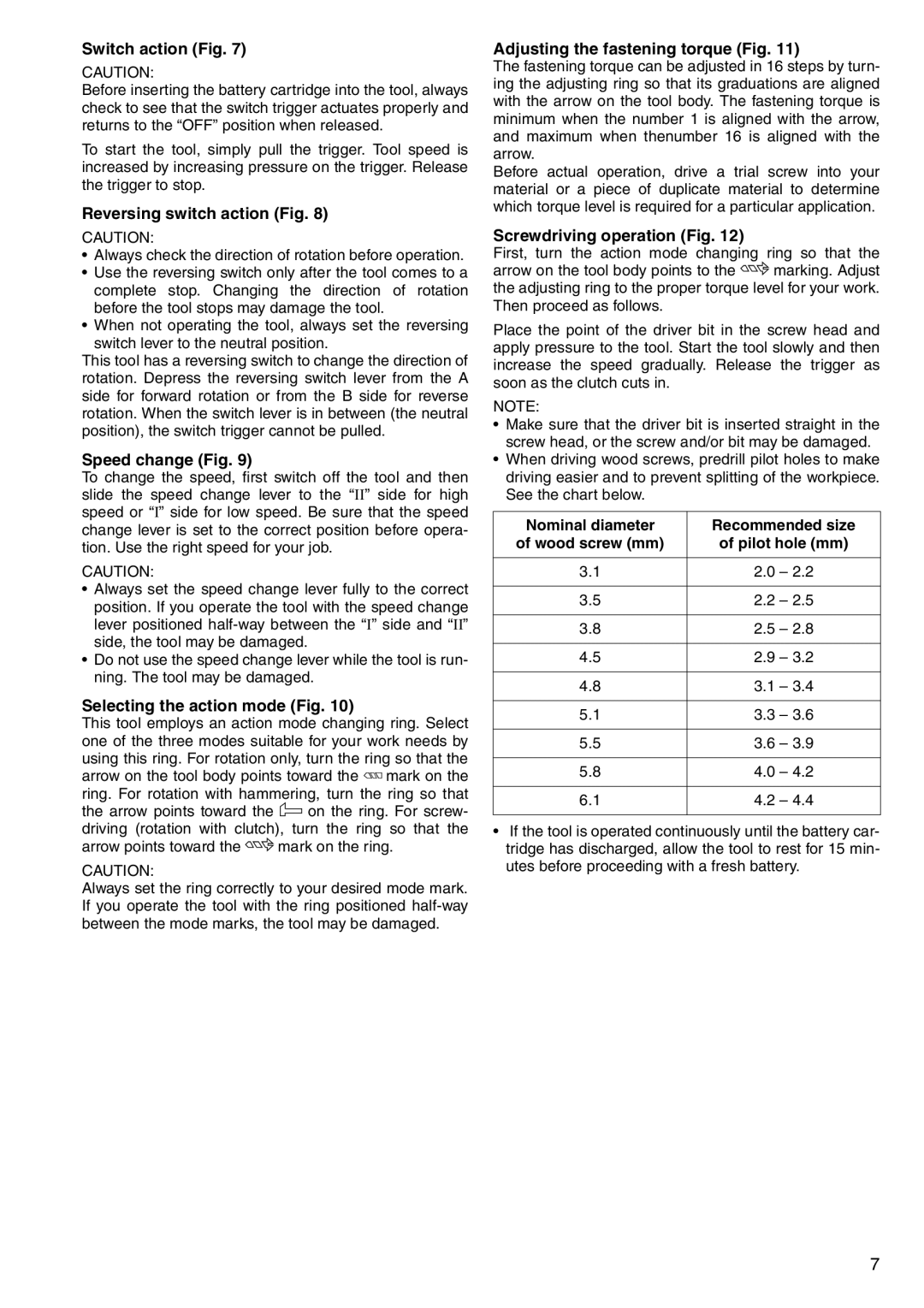Switch action (Fig. 7)
CAUTION:
Before inserting the battery cartridge into the tool, always check to see that the switch trigger actuates properly and returns to the “OFF” position when released.
To start the tool, simply pull the trigger. Tool speed is increased by increasing pressure on the trigger. Release the trigger to stop.
Reversing switch action (Fig. 8)
CAUTION:
•Always check the direction of rotation before operation.
•Use the reversing switch only after the tool comes to a complete stop. Changing the direction of rotation before the tool stops may damage the tool.
•When not operating the tool, always set the reversing
switch lever to the neutral position.
This tool has a reversing switch to change the direction of rotation. Depress the reversing switch lever from the A side for forward rotation or from the B side for reverse rotation. When the switch lever is in between (the neutral position), the switch trigger cannot be pulled.
Speed change (Fig. 9)
To change the speed, first switch off the tool and then slide the speed change lever to the “II” side for high speed or “I” side for low speed. Be sure that the speed change lever is set to the correct position before opera- tion. Use the right speed for your job.
CAUTION:
•Always set the speed change lever fully to the correct position. If you operate the tool with the speed change lever positioned
•Do not use the speed change lever while the tool is run- ning. The tool may be damaged.
Selecting the action mode (Fig. 10)
This tool employs an action mode changing ring. Select one of the three modes suitable for your work needs by using this ring. For rotation only, turn the ring so that the arrow on the tool body points toward the Mmark on the ring. For rotation with hammering, turn the ring so that the arrow points toward the Xon the ring. For screw- driving (rotation with clutch), turn the ring so that the arrow points toward the Umark on the ring.
CAUTION:
Always set the ring correctly to your desired mode mark. If you operate the tool with the ring positioned
Adjusting the fastening torque (Fig. 11)
The fastening torque can be adjusted in 16 steps by turn- ing the adjusting ring so that its graduations are aligned with the arrow on the tool body. The fastening torque is minimum when the number 1 is aligned with the arrow, and maximum when thenumber 16 is aligned with the arrow.
Before actual operation, drive a trial screw into your material or a piece of duplicate material to determine which torque level is required for a particular application.
Screwdriving operation (Fig. 12)
First, turn the action mode changing ring so that the arrow on the tool body points to the Umarking. Adjust the adjusting ring to the proper torque level for your work. Then proceed as follows.
Place the point of the driver bit in the screw head and apply pressure to the tool. Start the tool slowly and then increase the speed gradually. Release the trigger as soon as the clutch cuts in.
NOTE:
•Make sure that the driver bit is inserted straight in the screw head, or the screw and/or bit may be damaged.
•When driving wood screws, predrill pilot holes to make driving easier and to prevent splitting of the workpiece. See the chart below.
Nominal diameter | Recommended size |
of wood screw (mm) | of pilot hole (mm) |
|
|
3.1 | 2.0 – 2.2 |
|
|
3.5 | 2.2 – 2.5 |
|
|
3.8 | 2.5 – 2.8 |
|
|
4.5 | 2.9 – 3.2 |
|
|
4.8 | 3.1 – 3.4 |
|
|
5.1 | 3.3 – 3.6 |
|
|
5.5 | 3.6 – 3.9 |
|
|
5.8 | 4.0 – 4.2 |
|
|
6.1 | 4.2 – 4.4 |
|
|
•If the tool is operated continuously until the battery car- tridge has discharged, allow the tool to rest for 15 min- utes before proceeding with a fresh battery.
7
